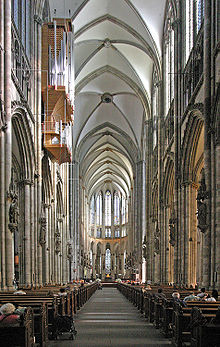When the early
Celtic tribes moved their way into France and Germany they also left behind
some of the earliest art forms there as well. Some of the earliest forms of art found here are primitive
human sculptures and golden hats of the Bronze Age, and much of this is in the
Celtic tradition. After
Christianity spread into the area following the reign of Charlemagne, the most
prominent art form was illuminated manuscripts. Crucifix sculptures were also
popular in larger cathedrals, and some were life size. Altarpieces, a type of
relief that was painted or carved that stood behind the altar as a backdrop,
were another highly elaborate art form from the Medieval period.
The biggest name
from the Renaissance period is Albrecht Dürer. He was well known for his engravings and prints that went
into printed books – something relatively new at this time. He also was known
as a painter. Sculpture remains an important during this time; however, it
branched out into ornamental flourishes in Gothic building design.
As Germany moved
its way through Baroque, Rococo, and Neoclassical styles, they also included artistic
movements and other styles from across Europe into their work as well. Caspar David Friedrich is one of the
leading artists in Germany during the Romantic period, or at least one of the
most well known. Much of the art
at this time was in painting landscapes and portraits. Shortly after this,
naturalism and realism took hold of German artists, and paintings started to
come alive. (Not literally.) Artists brought back elements of Greek art and Art
Nouveau.
 |
| by Caspar David Friedrich |
Fundamentalism,
expressionism, grotesque, Dadaism, and a number of other art movements
prevailed in the 20th century, some more avant garde than others. The
Nazi regime generally forbade any modern art style, electing to only approve
art done in the classical styles and the subject matter had to be
nationalistic. Conceptional art became very popular after WWII; some of the big
names include Bernd and Hilla Becher, Hans-Peter Feldmann, and Hans Haacke.
Joseph Beuys is also a well-known artist and sculptor, often giving
performances and lectures with his work. Today, there are numerous art
exhibitions at museums across Germany showcasing the best of their own artists.
 |
| by Joseph Beuys |
German literature
is primarily written in German, and generally includes literature from Germany,
Austria, and Switzerland. Obviously, I’m going to focus on the literature
coming out of Germany itself in this post. Early literature for the most part started around the
Reformation, although there were some pieces around before that, mostly epic
poetry. Romantic poetry, especially that of the courts and royalty, were
particularly popular. The heroic poems, stemming from the oral traditions, were
also beginning to be written down.
The Baroque period
brought forth the establishment of language rules and rules on poetry and
style, thanks to the efforts of Martin Opitz. This literary period also gave us the first German tragedies
as well as continuations in religious poetry.
The period of
Enlightenment was one of the key literary movements during the 18th
Century; writers such as Immanuel Kant, Christian Wolff, and Johann Gottfried
Herder were influential writers of this style. A movement called Sturm und Drang, characterized by periods
of strong emotions as a way of breaking out of the strict nationalism, was
shown in the works of Johann Wolfgang von Goethe (most notable for his work Faust) and Friedrich Schiller, who
later became known for their involvement and initiation of the Weimar
Classicism movement.
.jpg/250px-Goethe_(Stieler_1828).jpg) |
| Johann Wolfgang von Goethe |
German Romanticism
tended to value honor and wit as well as beauty. Karl Friedrich Schlegal and his brother August Wilhelm
Schlegal as well as Heinrich von Kleist and E.T.A. Hoffmann were prolific
writers of this period. Young
Germany, a group of writers associated with the Vormärtz writers included many
young writers and poets, Heinrich Heine being one of the most famous.
 |
| Heinrich Heine |
During the Nazi
regime, a lot of writers fled to safer countries, and the ones who stayed were
under strict censorship and forced to write Nazi propaganda materials. After
the war was over, postwar and postmodern literature tended to dominate the most
published genres. German writers also made their mark in science fiction,
fantasy, futuristic fiction, thriller, and pop fiction. Hermann Hesse is one of the most well-known authors who was born in Germany and won the Nobel Prize for Literature in 1946. I have read and own two of his most famous books: Steppenwolf and Siddhartha.
Up next: music and
dance



No comments:
Post a Comment